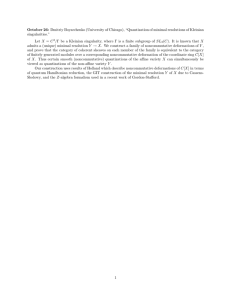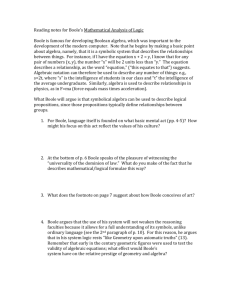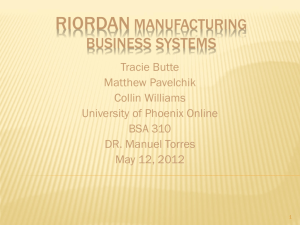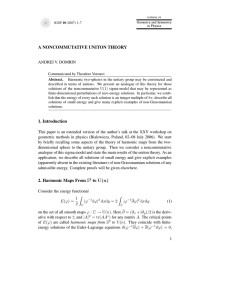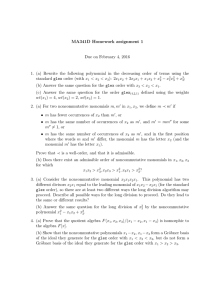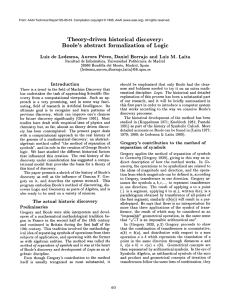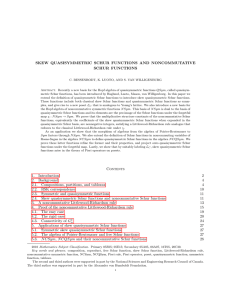The Annual September Meeting of the IMS University College Cork 27–28 August 2015
advertisement
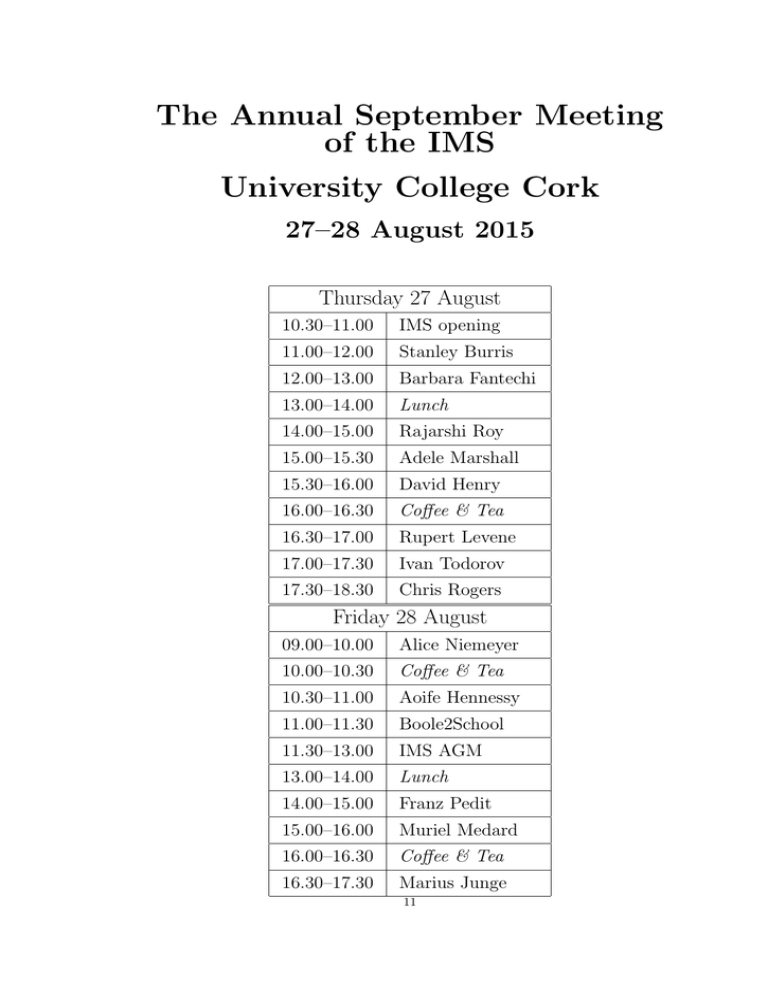
The Annual September Meeting
of the IMS
University College Cork
27–28 August 2015
Thursday 27 August
10.30–11.00
IMS opening
11.00–12.00
Stanley Burris
12.00–13.00
Barbara Fantechi
13.00–14.00
Lunch
14.00–15.00
Rajarshi Roy
15.00–15.30
Adele Marshall
15.30–16.00
David Henry
16.00–16.30
Coffee & Tea
16.30–17.00
Rupert Levene
17.00–17.30
Ivan Todorov
17.30–18.30
Chris Rogers
Friday 28 August
09.00–10.00
Alice Niemeyer
10.00–10.30
Coffee & Tea
10.30–11.00
Aoife Hennessy
11.00–11.30
Boole2School
11.30–13.00
IMS AGM
13.00–14.00
Lunch
14.00–15.00
Franz Pedit
15.00–16.00
Muriel Medard
16.00–16.30
Coffee & Tea
16.30–17.30
Marius Junge
11
12
The meeting was funded in part by the European Mathematical
Society, Science Foundation Ireland and University College Cork,
in conjunction with the IMS. There were 52 registered participants.
The timetable of the talks is above, and the abstracts are given
below.
Titles and Abstracts
Stanley Burris — A Primer on Boole’s Algebra of Logic
I will describe how Boole managed to squeeze an algebra of logic into
the algebra of numbers. The only background needed is high school
algebra and the distributive law from basic set theory: A ∩ (B ∪
C) = (A ∩ B) ∪ (A ∩ C). With this setup Boole proved his elegant
results on Elimination and Solution. Boole’s approach led to his
models being partial algebras since addition and subtraction were
only partially defined, and this led to his use of uninterpretables.
Boole’s main results were admired, but not his algebra-of-numbers
approach. Within a decade of his publication of Laws of Thought
his system was being replaced by the modern Boolean algebra which
had total algebras and was able to derive the same results.
Barbara Fantechi — Counting Curves on Algebraic Varieties
Enumerative geometry is one of the oldest parts of mathematics,
with entry-level problems that can be explained to the layman (given
four lines in space, how many lines meet/intersect all of them?). Yet
in recent decades stunning progress has come thanks to a synergy of
algebraic and complex geometry, string theory and function theory.
In this talk we give a very partial overview, highlighting the interplay
between concrete problems and theoretical advances.
Aoife Hennessy — Riordan Arrays and Bijections of Weighted Lattice Paths
This talk introduces Riordan arrays and concerns paths counted
by Riordan arrays arising from the decomposition of certain Hankel matrices and bijective relationships between them. We consider certain Hankel matrices, H under two decompositions, H =
LM DLTM with LM a Riordan array of generating functions that count
weighted Motzkin paths and a H = LL SDSLTL decomposition, with
LL a Riordan array with generating functions that count weighted
Lukasiewicz paths. A bijection is introduced between these paths.
13
References
[1] P. Flajolet, Combinatorial aspects of continued fractions, Discrete Mathematics 32 (1980), pp. 125–161.
[2] A. Hennessy, A study of Riordan arrays with applications to
continued fractions, orthogonal polynomials and lattice paths, PhD
Thesis, Waterford Institute of Technology, 2011.
[3] F. Lehner, Cumulants, lattice paths and orthogonal polynomials,
Discrete Mathematics 270 (2003), pp. 177–191.
David Henry — Exact Solutions of the Water Wave Problem
The equations of motion which govern fluid dynamics are highly
intractable to mathematical analysis for a variety of reasons, among
them being the inherent nonlinearity of the governing system of
partial differential equations coupled with the fact that one is often
dealing with a free-boundary problem whereby the fluid domain is
a priori unknown.
Recently, modern functional analytic techniques have enabled major
progress to be made in proving the existence of exact water wave
solutions to the fully nonlinear free-boundary value problem. In this
talk, which consists of recent work with various collaborators, I will
present some exact solutions to the governing equations of water
wave problems in two- and three-dimensions which have an explicit
form in the Lagrangian formulation, describing briefly how these
solutions are particularly amenable to a hydrodynamical stability
analysis.
Obligatory Boole reference: one of the major figures in the area of
hydrodynamical stability, Sir Geoffrey Ingram Taylor (1886-1975),
was none other than George Boole’s grandson!
Marius Junge — Analysis on Noncommutative Spaces
Noncommutative tori are simplest examples for noncommutative
mainfolds in noncommutative geometry. For these concrete spaces
and their noncompact analogues, we will discuss basic concepts from
noncommutative geometry and finite dimensional approximation in
the Gromov–Haussdorff sense. Using a semigroup approach one can
show that also many tools in classical harmonic analysis concerning
convergence of Fourier series and singular integral operators remain
14
valid in the context of noncommutative deformations of classical
spaces.
Rupert Levene — The Boolean Lattice of Schur Idempotents
A Schur idempotent is an infinite matrix A of ones and zeros with the
property that if the matrix of any bounded Hilbert space operator B
is changed by replacing bij with 0 whenever aij = 0, then we obtain
another bounded operator. We will introduce these objects and
consider an open problem concerning the generation of the Boolean
lattice of all Schur idempotents, touching on joint work with Ivan
Todorov (QUB) and Georgios Eleftherakis (Patras).
Adele Marshall — Predictive Analytics and Healthcare
Modelling Using Coxian Phase-type Distributions
Muriel Medard — Stormy Clouds: Security in Distributed
Cloud Systems
As massively distributed storage becomes the norm in cloud networks, they contend with new vulnerabilities imputed by the presence of data in different, possibly untrusted nodes. In this talk, we
consider two such types of vulnerabilities. The first one is the risk
posed to data stored at nodes that are untrusted. We show that
coding alone can be substituted to encryption, with coded portions
of data in trusted nodes acting as keys for coded data in untrusted
ones. In general, we may interpret keys as representing the size of
the list over which an adversary would need to generate guesses in
order to recover the plaintext, leading to a natural connection between list decoding and secrecy. Under such a model, we show that
algebraic block maximum distance separable (MDS) codes can be
constructed so that lists satisfy certain secrecy criteria, which we define to generalise common perfect secrecy and weak secrecy notions.
The second type of vulnerability concerns the risk of passwords being
guessed over some nodes storing data, as illustrated by recent cloud
attacks. In this domain, the use of guesswork as a metric shows that
the dominant effect on vulnerability is not necessarily from a single
node, but that it varies in time according to the number of guesses
issued. We also introduce the notion of inscrutability, as the growth
rate of the average number of probes that an attacker has to make,
one at a time, using his best strategy, until he can correctly guess
one or more secret strings from multiple randomly chosen strings.
15
Joint work with Ahmad Beirami, Joao Barros, Robert Calderbank,
Mark Christiansen, Ken Duffy, Flavio du Pin Calmon, Luisa Lima,
Paulo Oliveira, Stefano Tessaro, Mayank Varia, Tiago Vinhoza,
Linda Zeger.
Alice Niemeyer — The Divisibility Graph of a Finite Group
For a set of positive integers X, A. Camina and R. Camina introduced the Divisibility Graph of X as the directed graph with vertex
set X\{1} and an edge from vertex a to vertex b whenever a divides
b. For a group G let cs(G) denote the set of conjugacy class lengths
of non-central elements in G. Camina and Camina asked how many
components the Divisibility Graph of cs(G) has. In joint work with
Abdolghafourian and Iranmanesh we determine the connected components of the Divisibility Graph of the finite groups of Lie type in
odd characteristic.
The answer to this question is closely related to another kind of
graph defined for groups, namely the Prime Graph. The vertex set
of the Prime Graph of a finite group G is the set of primes dividing
the order of the group and two vertices r and s are adjacent if and
only if G contains an element of order rs. Williams investigated the
Prime Graph of finite simple groups and determined its connected
components.
Franz Pedit — Integrable Surface Geometry for Surfaces of
Non-abelian Topology
We give a short historical introduction to the theory of constant
mean curvature surfaces and discuss recent advances for surfaces
whose fundamental groups are non-abelian. We explain how to use
the Riemann-Hilbert correspondence between local systems, representation varieties and holomorphic bundles to give a description
of those surfaces in terms of algebro-geometric data. Computer
experiments and visualisations support and guide the theoretical
investigations making the talk quite accessible to non-experts.
Chris Rogers — Fundamental Fallacies of Finance
The Concise Oxford Dictionary defines a fallacy as “A mistaken
belief esp. based on unsound argument”, and the history and current practice of the finance industry provides egregious examples.
This talk will fearlessly expose some of these, beat up the unsound
arguments, and, unexpectedly, offer some practical suggestions on
16
how to avoid such errors. These suggestions are unlikely ever to be
adopted, for reasons that will also be explained.
Rajarshi Roy — Seeing the Light: Visual Illusions and Reference Frames
The eye and brain work together to provide us with perspectives of
reality. Signals from the eye to the brain determine what we see
and how we interpret images and the dynamical, changing world
around us. We will explore simple and complex aspects of “seeing the light” - from the formation of images to their interpretation
based on frames of reference that lead us to impressions of the world
around us. Visual illusions and demonstrations with simple apparatus will be used to illustrate how eyes and brain work together to
help us navigate our way through life with balance and poise.
Ivan Todorov — Positive Extensions of Schur Multipliers
In this talk I will describe the positive completion problem for matrices, give a summary of known results and then discuss generalisations of these results in infinite dimensions. I will highlight the
operator space approach to the topic, in which completely positive
maps play a decisive role. Time permitting, I will give some applications of the results to the problem of extending positive definite
functions defined on subsets of locally compact groups.
Joint work with R. Levene and Y.-F. Lin,
Report by Stephen Wills, University College Cork
